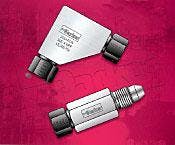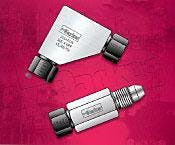New flow diverters, carbide clad gripper pads
A newly introduced line of flow diverters incorporates wear resistant properties.
The company's cladding process infiltrates tungsten carbide into the substrate of the base material, forming a hard, uniform protective layer that promises superior wear and is virtually impervious to chipping and flaking.
Diverters are available in a variety of sizes as well as in custom-engineered configurations.
The firm also offers its line of tungsten carbide clad gripper pads. They are available in flat plate and semicircle designs for use with various makes and models of hydraulic power tongs. Gripper pads come in carbon steel and heat treatable, low-alloy steel (type 4140).
Source: Conforma Clad Inc., 501 Park East Blvd., New Albany, IN 47150.
Deepwater gulf services agreement extended
C&C Technologies Inc., Lafayette, La., and Century Subsea Ltd., Aberdeen, Scot land, have extended their alliance for an additional 3 years, an agreement that calls for the two firms to continue to provide deepwater construction companies operating in the Gulf of Mexico with a range of survey services.
Those services include flowline and umbilical installation, template and spar installation, subsea metrology, and deepwater acoustics.
Source: C&C Technologies Inc., 730 E. Kaliste Saloom Rd., Lafayette, LA 70508.
New hydrate inhibitors for deepwater operations
New HI-M-PACT low-dosage hydrate inhibitors now on the market are designed to help deepwater oil and gas operators inhibit hydrate plugging. In field uses, the company says the inhibitors have achieved cost savings in production systems designed for conventional methanol treatment.
Based on antiagglomerant technology, these inhibitors disperse hydrates into the liquid hydrocarbons. Dosage rates are typically 1/40th that of conventional inhibitors, the firm says.
With the inhibitor, total costs for existing production systems are expected to be cut by as much as 50%, the company notes. The greatest savings are expected in the design of new production systems through the use of narrower treatment flow lines, reduction of premium deck space for treatment storage tanks, and incremental hydrocarbon recovery.
Source: Baker Hughes Inc., Baker Petrolite Div., 12645 W. Airport Blvd., Sugar Land, TX 77478.
New fittings for deepwater exploration uses
This new line of instrumentation connectors is designed to meet the needs of deepwater oil and gas exploration systems and equipment.
The MPI fitting is specially engineered to meet the needs of connector requirements for offshore deepwater drilling.
Fittings are designed to handle pressures of 6,000-15,000 psi.
Each fitting has a longer tube support section, compared with traditional compression fittings, the firm points out. This feature provides improved resistance to vibration and line loads.
The front SUPARCASE ferrule grips onto the tube as it moves down the body seat, creating a pressuretight seal on the tube and body. The rear SUPARCASE ferrule then moves inward into the cone of the front ferrule and is pushed into the tube creating a second mechanical hold on the tube. Fittings can be used on 316 stainless steel cold drawn-1/8 hard (unannealed) tubing or thick-walled (annealed) instrumentation grade 316 tubing."
Fittings also feature an inverted nut coated with molybdenum disulfide to help prevent galling, permit easier assembly, and multiple remakes. Standard fittings are made of heat code traceable 316 stainless steel.
Source: Parker Hannifin Corp., Box 400004-1504, Huntsville, AL 35815-1504.
Petrophysical package for multiwell use
ULTRA, a specialty application, is a new package of petrophysical tools for use in multiwell environments. Based on probabilistic analysis, it provides estimates of wellbore lithology and fluid properties for the entire reservoir.
ULTRA leverages statistical optimization techniques that analyze variation in borehole conditions and uncertainty in tool response to provide a probabilistic model of reservoir properties. From an easy-to-use interactive interface, users are able to specify which measurements, assumptions, local knowledge, or geological and geophysical constraints to apply in the modeling.
Source: Landmark Graphics Corp., 2101 City West Blvd., Houston, TX 77042-2827.
New heat transfer fluid
Thermogreen is a new heat transfer fluid that promises to boost heat transfer rates as much as 40%.
The water-based product is designed for indirect line heaters, vaporizers, and process heating loops, directly replacing glycol/ water fluids that are now commonly used.
With higher thermal conductivity and heat capacity and lower viscosity, the product helps improve heat transfer when compared with glycol-based fluids, the company says. Considered a non-VOC, Thermogreen biodegrades rapidly if released into the environment with much less oxygen demand than glycols. Thermogreen is safe to handle and maintain, with low toxicity toward humans, mammals, and fish.
Source: Clearwater Inc., 5605 Grand Ave., Pittsburgh, PA 15225.
Refinery wastewater treatment prouducts outlined
A complete range of wastewater treatment products and services for refineries and petrochemical plants is outlined in a new 16-page brochure, yours free upon request.
It describes equipment supply; pilot study, design, engineering, construction, operation, and management services; process optimization of upstream and downstream facilities; and monetizing of wastewater treatment assets.
Source: USFilter, Box 1604, Waukesha, WI 53186.



